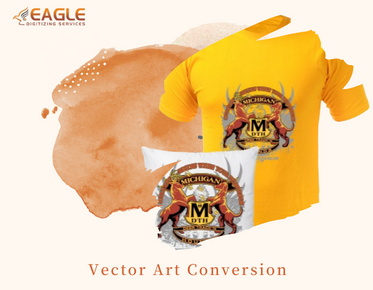Stitch by Stitch: Understanding Digitized Embroidery Stitch Types and Uses
Embroidery is not
just about beautiful designs; it’s also about the techniques that bring those
designs to life. Understanding the various digitized embroidery stitch types is
crucial for achieving the desired effect in your projects, whether you're
creating logos, patches, or intricate artwork. Each stitch type serves a
specific purpose and offers different textures and appearances, making it
essential to choose wisely based on your design goals. In this article, we'll
delve into the most common stitch types used in digitized embroidery and
explore their unique applications, helping you elevate your embroidery game to
new heights.
Why Choosing the Right Stitch Matters
The choice of
stitch type can make or break an embroidery project. Each stitch possesses
unique characteristics, influencing the overall look, texture, and durability
of the final product. Selecting the right stitch type is akin to a painter
choosing the perfect brush; it profoundly affects how the design is interpreted
and perceived. A well-chosen stitch enhances not only the aesthetic appeal but
also the functionality of the embroidery, ensuring it withstands the rigors of
wear and time.
Satin Stitch: The Classic Choice
What
is Satin Stitch?
Satin stitch is a
luscious, smooth embroidery technique characterized by tightly packed parallel
stitches that create a luxurious, velvety surface. This stitch is often used
for lettering and shapes, as it provides a polished, professional finish that
elevates any design. The key to achieving the hallmark sheen of satin stitch
lies in its density and thread placement, which together form a cohesive look
that is both visually striking and texturally rich.
When
to Use Satin Stitch: Best Applications
Satin stitch
shines brightest in applications where a sophisticated appearance is desired.
It’s particularly well-suited for logos, monograms, and decorative elements on
garments, bags, and home decor. The versatility of satin stitch makes it a
favorite among embroiderers, whether used for bold, eye-catching designs or
delicate accents.
Tips
for Achieving Perfect Satin Stitch Results
To ensure your
satin stitch is flawless, pay careful attention to thread tension and needle
choice. A sharp needle will prevent fraying and snagging, while appropriate
tension settings will help maintain even stitching. Additionally, stabilizers
can be invaluable in preventing distortion, especially on lightweight fabrics.
With practice and patience, you can master the satin stitch, creating exquisite
designs that captivate the eye.
Fill Stitch: Adding Depth and Texture
Understanding
Fill Stitch and Its Variations
Fill stitch is a
foundational embroidery technique used to cover larger areas with thread,
adding depth and texture to designs. This stitch can vary in density and
direction, allowing for an array of visual effects. Variations such as underlay
stitches or crosshatching can further enhance the dimension, making fill
stitches a versatile choice for complex designs.
Creative
Uses for Fill Stitch in Design
Fill stitch
excels in designs where richness and detail are paramount. It’s commonly
employed to create shaded areas in floral motifs, animal patterns, and even
abstract art. The ability to play with different stitch directions and
densities allows for endless creativity, enabling embroiderers to craft unique
pieces that stand out.
Pros
and Cons of Using Fill Stitch
While fill stitch
offers many advantages, it is not without its drawbacks. On the plus side, fill
stitch creates a vibrant, textured look that can elevate any design. However,
it may add weight and stiffness to the fabric, which is a consideration when
working with lighter materials. Understanding when to utilize fill stitch
versus other techniques is key to achieving the desired aesthetic without
compromising the fabric's drape.
Running Stitch: The Versatile Workhorse
What
is a Running Stitch?
Running stitch,
perhaps the most fundamental of all stitches, consists of a simple, continuous
line of stitching. This straightforward technique offers versatility and ease,
making it a staple in both hand and machine embroidery. Its unobtrusive nature
allows it to serve as both a structural component and a decorative element in
various designs.
Ideal
Applications for Running Stitch
Running stitch is
incredibly versatile, finding applications across a wide range of embroidery
projects. It is ideal for outlining shapes, adding details, and even creating
intricate patterns. Additionally, its lightweight nature makes it perfect for
delicate fabrics where a more subtle effect is desired, such as on sheer
garments or lightweight quilts.
Enhancing
Designs with Decorative Running Stitch Techniques
Running stitch
can be embellished with decorative techniques to elevate its visual impact.
Variations such as the backstitch or dashed line can add interest and texture,
transforming the ordinary into the extraordinary. Incorporating these
variations into your designs can enhance their complexity while maintaining the
simplicity that makes running stitches so appealing.
Zigzag Stitch: A Creative Flair
What
Makes Zigzag Stitch Unique?
Zigzag stitch,
with its distinctive pointed peaks and valleys, brings a playful flair to
embroidery. This stitch is often employed to create borders, decorative
accents, and even as a means of securing edges. Its unique formation not only
adds visual interest but also enhances the durability of the fabric, making it
a practical choice for various applications.
Practical
Uses for Zigzag Stitch in Embroidery
Zigzag stitch is
a workhorse in embroidery, often utilized for reinforcing seams, finishing
edges, or adding decorative borders. Its ability to stretch makes it
particularly suited for knit fabrics, where it can provide the necessary
flexibility without compromising integrity. Additionally, it’s a fantastic
choice for creating waves or dynamic patterns that draw the eye.
How
to Master Zigzag Stitch for Eye-Catching Designs
To create
captivating zigzag designs, attention to detail is paramount. Adjusting stitch
width and length can dramatically alter the stitch's appearance, allowing for
customization based on project needs. Experimenting with color and layering
zigzag stitches can also enhance designs, providing depth and movement that
captivates onlookers.
Chain Stitch: A Timeless Technique
Exploring
Chain Stitch and Its Characteristics
Chain stitch,
characterized by its looped design, offers a unique texture that is both ornamental
and functional. This stitch not only serves as a decorative element but also
has historical significance, often seen in traditional embroidery techniques
worldwide. Its flowing nature adds an organic quality to designs, making it a
favored choice among artisans.
Contemporary
Applications: How to Use Chain Stitch Today
Today, chain
stitch is embraced by both traditionalists and modern embroiderers alike. Its
unique aesthetic makes it perfect for embellishing clothing, home decor, and
artistic textiles. By experimenting with color combinations and varying stitch
lengths, contemporary artisans can breathe new life into this timeless
technique, creating striking pieces that pay homage to its storied past.
Outline Stitch: Defining Your Design
What
is Outline Stitch and When to Use It?
Outline stitch,
as its name implies, is designed to define shapes and borders. This stitch is
particularly useful for accentuating details, and creating clear demarcations
within a design. It’s often used in conjunction with other stitches to provide
structure and definition, enhancing the overall clarity of an embroidery piece.
Enhancing
Designs with Outline Stitch Techniques
Outline stitch
can be manipulated in various ways to enhance its visual appeal. By adjusting
stitch density or combining it with other stitch types, you can create layered
effects that add depth and interest. Utilizing contrasting thread colors can
further amplify the impact of outline stitch, drawing attention to key elements
within a design.
Combining
Outline Stitch with Other Stitches for Unique Effects
The beauty of an
outline stitch lies in its ability to harmonize with other stitches. By
layering outline stitches with fill or satin stitches, you can create intricatedesigns that boast both texture and clarity. Experimenting with different
combinations opens a world of possibilities, allowing for innovative designs
that capture the imagination.
French Knot: Adding Texture and Detail
What
is a French Knot?
The French knot,
a delightful stitch, adds dimensionality and texture to embroidery projects.
This whimsical knot is created by wrapping the thread around the needle before
pulling it through the fabric, resulting in a small, raised dot. Its playful
nature makes it an excellent choice for adding intricate details and decorative
flair to designs.
When
and How to Use French Knots in Your Designs
French knots
shine in applications where detail and texture are paramount. They can be used
to create floral centers, accents, or even as standalone embellishments.
Mastering the technique involves practice, but the results—a charming array of
textured dots—are well worth the effort.
Creative
Ideas for Incorporating French Knots
The possibilities
for incorporating French knots are virtually limitless. They can add a pop of
color to a design, create delicate patterns, or serve as focal points in a
larger composition. Experimenting with varying sizes and thread colors allows
for a dynamic visual effect that elevates any embroidery project.
Bar Tack Stitch: Reinforcing Your Work
Understanding
Bar Tack Stitch and Its Purpose
The bar tack
stitch, a robust and sturdy stitch, serves a critical role in reinforcing areas
of stress in embroidered projects. Often used at the ends of buttonholes or to
secure fabric layers, this stitch ensures durability where it’s needed most.
Its strength makes it an essential choice for functional embroidery.
Applications
for Bar Tack Stitch in Embroidery
Bar tack stitches
find their place in a variety of applications, from garment construction to
decorative accents. They are particularly useful in areas that experience wear
and tear, ensuring that your embroidery withstands the rigors of everyday use.
Incorporating bar tack stitching into your designs can significantly enhance
their longevity and resilience.
How
to Ensure Effective Bar Tack Stitching
To achieve
effective bar tack stitching, proper placement and technique are key. Ensuring
that the stitch is adequately anchored can prevent fraying and unraveling.
Additionally, utilizing stabilizers and choosing the right thread weight can
enhance the stitch's strength, providing the support necessary for long-lasting
embroidery.
Specialty Stitches: Unique Options for Custom Designs
Exploring
Specialty Stitches: What Sets Them Apart?
Specialty
stitches offer a unique alternative to traditional embroidery techniques,
allowing for creative expression and personalization in your projects. These
stitches, which often incorporate unconventional methods or combinations, can
elevate designs and introduce intricate details that set them apart.
Examples
of Specialty Stitches and Their Uses
Specialty
stitches encompass a wide range of techniques, from raised embroidery to
dimensional stitches like bullion knots. These options can be used to create
unique textures, shapes, and patterns that captivate and inspire. Incorporating
specialty stitches into your designs can transform a simple piece into a work
of art.
When
to Opt for Specialty Stitches in Your Projects
Choosing
specialty stitches is ideal when you aim to push the boundaries of traditional
embroidery. These stitches can enhance focal points in your design or provide
textural contrast against standard stitches. However, consider the overall
coherence of your design, as the goal is to create a harmonious composition
that reflects your creative vision.
Mastering the various digitized embroidery stitch types empowers you to make informed choices that enhance your designs and overall project quality. By understanding the unique characteristics and applications of each stitch, you can create visually striking and professionally finished pieces. Whether you’re crafting custom apparel or decorative items, applying the right stitches will ensure your embroidery truly stands out.



